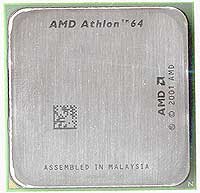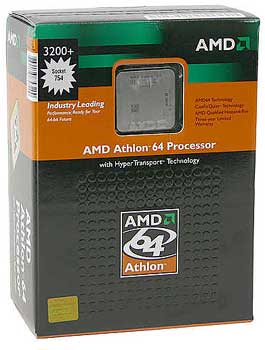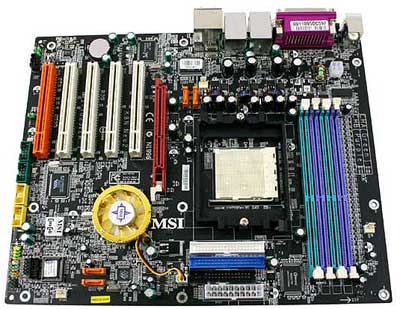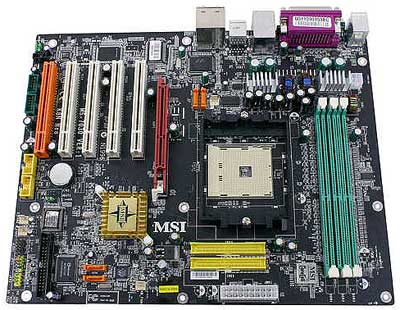Buyer's Guide - Mid-Range, October 2004
by Jarred Walton on October 21, 2004 11:00 AM EST- Posted in
- Guides
AMD CPU and Motherboard Recommendations
As we mentioned before, AMD has a decent performance lead in software development applications. Those of you who code for a living, not to mention users who like to use Linux, will probably want to go with an Athlon 64. These processors tend to compile code significantly faster than Intel processors, which is a common task in Linux use. Anyone who has tried to debug code knows how much shorter compile times help out. At times, you might be tweaking one or two lines of code, followed by a recompile and test of the changes; one small change can sometimes require several minutes of compiling and linking!Having settled on AMD, we are still greeted with a couple choices. Socket A is no longer a recommended option, due to its lack of performance as well as the looming end of the platform. Socket 754 and 939, however, are both reasonable choices. The difference here is that socket 754 tends to be cheaper for the same amount of performance, while socket 939 is more likely to have future processor upgrades available. Socket 939 boards should also start shipping with PCI Express support in the next month or two, which is something to consider. You can read more about this in our preview of NVIDIA's upcoming Nforce4 chipset. If those chipsets interest you, waiting another month or so might be wise. If you're looking to buy right now, you can choose the great price/performance of socket 754 with its limited CPU upgrades, or you can go with socket 939 with a slightly higher cost, but with the capability to upgrade to at least the FX-55/4000+ CPUs in the future.

AMD CPU Recommendation: AMD Athlon 64 3200+ 512K 2.0 GHz 90 nm (939)
Price: $215 Shipped (OEM)
Without spending a lot of money on a processor, the only reasonably priced chips for socket 939 are the new 90 nm Athlon 64 chips, a.k.a. Winchester. We published our initial look at these processors just last week, and they finally bring socket 939 to the mainstream price segment. Overclocking seems to work quite well on these chips, for those who are interested in that sort of thing. One minor problem with these new chips is that they are currently only available in OEM form, so you will need to purchase a separate heatsink and fan (HSF). We generally prefer Retail boxed processors as they include a certified HSF and do not cost much more than their OEM counterparts, and they also include a manufacturer 3-year warranty. That said, it has been quite a while since the last time we experienced a CPU failure. Those looking for more performance on a socket 939 platform can turn toward the 3500+, 3800+, and even the FX-53/4000+ and FX-55, but most of those are priced for the high-end segment. You might also be able to find a 3000+ 90 nm part for under $200, although they appear to be scarce right now and it might be another month before availability becomes widespread.

CPU Heatsink and Fan Recommendation: Spire KestrelKing III
Price: $20 Shipped
The HSF that we chose to go with the socket 939 CPU is the Spire KestrelKing III, but just about any socket 939 compatible HSF will do the trick. If you read our article on the new 90 nm Athlon 64 processors, you'll recall that they do not appear to generate a whole lot of heat. You could spend $30 or more on a high-end HSF, but for typical use, it isn't necessary.

AMD CPU Alternative: AMD Athlon 64 3200+ 512K 2.2 GHz (754)
Price: $200 Shipped (Retail)
You'll notice that the prices for AMD processors all dropped recently with the release of the FX-55 and 4000+ CPUs. This is welcome news to anyone who is in the market for a new system, and it allows us to increase the performance of our system relative to our last Mid-Range Guide without increasing the cost. $200 tends to be the sweet spot for processors and we see that here with the Athlon 64 3200+. At 2.2 GHz, it's 10% faster than the A64 3000+, and although it does cost about 20% more, we feel that this is acceptable for a Mid-Range computer. The 3400+ is also an option for additional performance and at 2.4 GHz, it is only slightly slower than the 3700+ and 3800+ at roughly half the cost. Our past tests have shown that the additional 512K of L2 cache does not usually boost performance of the Athlon 64 processors as much as an additional 200 MHz of clock speed will, so we recommend the Newcastle cores over the Clawhammer variants.
If you are interested in spending less for slightly slower performance, the Athlon 64 2800+ is now available for $140. The Sempron 3100+ will also work in socket 754, but it is difficult to recommend in this price segment as it lacks 64-bit support and has half as much L2 cache as the 2800+ while it only costs $17 less. In the future, though, Sempron may be the only option for socket 754 beyond the A64 3700+, as AMD is pushing the socket as its value platform with socket 939 being the performance choice. You can read more about this is our recent AMD Roadmap update. This is why we leave it as an alternative suggestion. If the $1250 price point is a bit too high for your budget, socket 754 is a great way to cut costs without cutting performance.

Socket 939 Motherboard: MSI K8N Neo2 Platinum
Price: $131 Shipped
The selection for socket 939 motherboards is relatively limited. At present, there are only three or four boards available at retail that use the nForce3 chipset, and there are another five or six boards that use the K8T800 Pro chipset. Perhaps it is simply a case of companies waiting for the PCI Express chipsets to become available, but whatever it is, the selection is not very large. Prices range from about $110 for the cheapest K8T800 Pro based boards up to $130 or so for the MSI board that we selected, and then there is an "everything plus the kitchen sink" Gigabyte board for around $200. We continue to recommend the MSI K8N Neo2 Platinum for its price, performance, and features. It does have one flaw worth pointing out, though: the heatsink on the NF3 chipset is very close to the AGP slot and can make the installation and removal of large graphics cards, like the 6800 Ultra, difficult. If that's a deal-breaker for you, you might want to check out the EPoX EP-9NDA3+.
For those who prefer something other than an NVIDIA chipset, we feel that the Soltek SL-K8TPro-939 and the MSI K8T Neo2-FIR are similarly equipped alternatives that are worth a look. Abit and ASUS also have boards that are worth considering, as they both cater heavily to the performance/enthusiast market.
There really aren't any truly inexpensive alternatives for socket 939 yet, and almost all of the boards come equipped with 8-channel audio, GbE, and Firewire support. If you don't need those features, you still have to pay for them. You also get 4 DIMM sockets on all the boards, and they should all work properly at PC3200. This is a nice change from socket 754. PCI Express is right around the corner on socket 939, but the performance is generally about the same as equivalent AGP. There are several graphics cards at attractive prices that are only for PCIe right now, so after you read our graphics recommendations, you might decide that it's worth waiting for. For non-gaming use, however, it probably won't matter much.

Socket 754 Motherboard: MSI K8N Neo Platinum
Price: $122 Shipped
The choice of motherboard, particularly for socket 754, is rather difficult. We have chosen the MSI K8N Neo Platinum based on price and features. It includes full support for the nForce3 250Gb chipset, which means it has gigabit Ethernet with a hardware firewall. It also includes support for up to 3 Firewire ports, 4 SATA devices, and 8 channel audio. Similarly equipped boards such as the DFI LANPARTY UT nF3, the ASUS K8N-E Deluxe, and the Chaintech ZNF-250 are also possibilities that all cost about the same as the MSI board. Performance may be slightly better with some of these boards, but we have not had any complaints with the MSI board and continue to recommend it. The ZNF-250 has some extra goodies in the package like a flash memory reader that might make it worth the additional cost.
Those interested in a better price can take a look at boards like the Chaintech VNF-250 and EPoX EP-8KDA3J, as well as a large number of other boards. We still prefer the nForce3 250 chipset over the VIA K8T800 Pro, mainly on the basis of features, but to those looking for a VIA alternative, the only readily available motherboard using the newer chipset is the Abit KV8 Pro. Unfortunately, it costs more and compares rather poorly with the Chaintech board. The differences between the K8T800 and the "Pro" are relatively minor, so you could also opt for an older board like the Asus K8V. One thing to look out for is that many of the older socket 754 boards have problems running two or more DIMMs at PC3200 speed, which is why we recommend boards that use the newer chipsets. The other side of the story is that there are also many cheaper socket 754 boards that only come with two DIMM slots, which obviously gets around the difficulty of running three DIMMs by simply avoiding that option.
The bottom line is that the battle for price/performance still belongs to socket 754, but not by a lot. It's a tough call, but we give the edge to the socket 939 configuration as it has a better outlook in terms of longevity. By the time that you're ready to upgrade to a faster CPU, however, you might need to upgrade to a newer motherboard anyway.










54 Comments
View All Comments
Avalon - Friday, October 22, 2004 - link
For the s754 system, to clarify. Sorry. Wish these posts could be edited :)Avalon - Friday, October 22, 2004 - link
If you wanted to cut an additional ~$50, switch out that MSI K8N Neo Platinum and throw in an Epox 8KDA3J. It's only $73 on newegg, shipped, which is within a dollar or two of the Chaintech VNF-250, but has loads more features. After all, you guys gave the 8KDA3+ an editor's choice award, so why not recommend the "value" board in a mid range rig? It's an option to ponder over.dragonballgtz - Thursday, October 21, 2004 - link
A $200 CPU would go better with a 9800Pro IMHO for gamers.JarredWalton - Thursday, October 21, 2004 - link
ksherman, that's basically what I went with, but outside of gaming there is no real need for a fast graphics card. $200 for a graphics card that many people do not want/need is difficult to justify. Rather than create more confusion with talk of gaming alternatives, we are going to look at putting together a Gaming Guide in the near future.The Mid-Range PC is such a broad segment that it is virtually impossible to cover all options without writing a 20,000 word article. This one is already long enough, and that was after I removed the gaming options. Here's the basics, though:
If you want a moderate gaming card for AGP, about the only reasonable choice right now is a 9800 Pro. The 6800/6800GT are too expensive for most people, I think. PCI Express has the 6600GT which tends to be faster than the 9800 Pro by about 10 to 20%. As games are GPU limited in most cases, AMD fans will probably either want to wait for PCI Express motherboards and get a 6600GT, or else bite the bullet and spend $360+ on a 6800GT. Ouch. :)
Beenthere - Thursday, October 21, 2004 - link
Nice guide. Lotta work !!!I think the biggest issue for most folks looking to build a new PC or even to upgrade within a budget, is prioritizing. As you can see from the comments above, gamers always want a top-of-the-line Video card even when this takes a big bite outta the budget. To do that you gotta cut cost some place else and that may compromise the total system performance.
Seems to me that an easy means to quantify and qualify the real options for an individual system would be by listing the hardware categories as you've done on a spreadsheet then plug in the hardware and prices accordingly. I think some folks would be surprised to see how their total system price climbs way beyond their original budget when you add $50. here and there to get the "best" of a particular component or to step up to the next level of component.
As you pointed out, sometimes like with memory, buying the lowest latency modules may cost more than moving up 200 MHz in CPU speed, so the CPU may be a better choice. Your guide and recommendations give PC builders a great head start on getting the most bang-for-their-buck.
Thanks for the effort!
ksherman - Thursday, October 21, 2004 - link
also, I think that a good description for a mid range system should be a system with a good amount of power (hence the processor choice) with out the price premium. I like mid-ranges because they offer the power i need with the versitility to do anything I will need to do for a while down the road.ksherman - Thursday, October 21, 2004 - link
It is kinda weird that you recommend such a low-end card for a mid-range system... to me (as everyone else has stated) the 6600 and 9800's should be in the midrange systems. 9600 and similar should be put into low-end systems... in regards to the x300, you state that it is good for those not into gaming so much as other "basic computing tasks", I think that something like that belongs in the low-end systems category.JarredWalton - Thursday, October 21, 2004 - link
I have made a few minor corrections, and I also added a $1000 AMD 754 system to the summary page, for those that might feel $1250 is too much. :)#3: Corrected, thanks. MB, GB... sometimes my fingers have a mind of their own.
#7: RAID 1 hardware controllers should not incur any noticeable performance penalty, as they simply tell both hard drives to write the same data. Better RAID 1 controllers will actually have improved read performance, as they can pull data from two sources. I have not done any extensive testing of this, however, and would guess that most integrated RAID controllers lack that feature. If anyone knows for sure, speak up.
#12: I didn't put much of an emphasis on gaming, as I hope to cover that more in an upcoming Gaming Guide. We'll see if that gets a green light - it's been a while since we covered that topic in depth, I think, although the Doom 3 craze touched on it.
#15: Stay tuned. That's all I will say for now. The Pioneer is still a good choice, though.
#16: Is that typo corrected now? If not, which page are you seeing that on, since I checked both the Display and Summary pages for the error.
Thanks!
Desslok - Thursday, October 21, 2004 - link
That monitor costs as much as the whole system would?NEC/Mitsubishi FE991SB-BK 19" 1274?????
deathwalker - Thursday, October 21, 2004 - link
Great article...I am a little surprised at the Optical Drive choice of the NEC 3500A @ $73, reason being is that you just reviewed the Pioneer 108 and called it the best drive reviewed to date and its only $78.